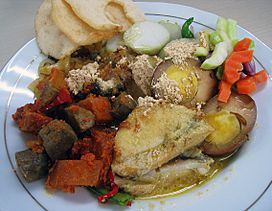Lontong cap go meh facts for kids

A plate of lontong cap go meh
|
|
| Course | Main course |
|---|---|
| Place of origin | Indonesia |
| Region or state | Java, Nationwide |
| Serving temperature | Hot |
| Main ingredients | Lontong topped with opor ayam, sayur lodeh, sambal goreng ati, pindang telur, koya powder, sambal, and krupuk |
Lontong cap go meh (which means 'Lontong for the 15th night' in Javanese) is a special meal. It mixes traditional Indonesian and Chinese Indonesian cooking styles. This dish is very popular in Java, a big island in Indonesia.
It features lontong, which is a rice cake. This rice cake is served with many tasty side dishes. These include opor ayam (chicken in coconut milk) and sayur lodeh (a vegetable soup). You also get spicy liver, a special hard-boiled egg, and koya powder. Koya is made from ground soybeans and dried shrimp. Pickles, chili paste, and prawn crackers complete the meal. People usually eat Lontong cap go meh during the Cap go meh celebration. This is a special holiday for Chinese Indonesian communities.
Contents
What's in Lontong Cap Go Meh?
Lontong cap go meh is not just one dish. It's like a full meal with several different parts. Think of it like a big platter of food, similar to nasi campur. Each part is often cooked separately. Then, they are all put together on one plate when it's time to eat. This rich mix of dishes shows how special and festive the meal is. It's a traditional part of the Cap go meh celebration in Java.
Here are the main parts of Lontong cap go meh:
- Lontong: This is a long rice cake. It is cooked inside a banana leaf.
- Opor ayam: This is a chicken stew. The chicken is cooked in creamy coconut milk with many spices.
- Sayur lodeh: This is a soup with different vegetables. It's also made with coconut milk. Sometimes, sayur labu siam (chayote in coconut milk soup) is used instead.
- Sambal goreng ati: This dish has beef liver. It's fried with spicy sambal chili paste.
- Telur pindang: These are hard-boiled eggs. They have a special marbled look and taste.
- Koya powder: This is a mix of ground fried soybeans and dried shrimp powder. Sometimes, abon (beef floss) is added or used instead.
- Acar: These are pickles. They usually have cucumber, carrot, small onions, and tiny chili peppers.
- Sambal: This is a spicy chili paste. It often contains terasi, which is a shrimp paste.
- Kerupuk: These are crispy prawn crackers. Sometimes, emping crackers are used instead.
The Story Behind the Dish
How Chinese and Indonesian Foods Mixed
You can see how Chinese food has influenced Indonesian food. Think of dishes like mie goreng (fried noodles), lumpia (spring rolls), bakso (meatballs), and siomay (dumplings). But the influence also went the other way! Peranakan Chinese Indonesian cooking has also been shaped by local Indonesian dishes. Many people believe that Lontong cap go meh is a great example of this mix. It's a Peranakan Chinese Indonesian twist on traditional Indonesian meals.
Early Settlers and New Traditions
Long ago, Chinese immigrants came to Indonesia. They settled in cities along the northern coast of Java. Places like Semarang, Pekalongan, and Surabaya were popular. This happened as early as the Majapahit period (a powerful ancient kingdom). At that time, mostly Chinese men came to Java. They often married local Javanese women. This led to a new culture called Javanese-Chinese Peranakan.
These early Chinese settlers got used to the cooking of their Javanese wives. When it was time to celebrate Chinese New Year and Cap go meh, they made a change. Instead of the traditional yuanxiao (sweet rice balls), they used local lontong. They served it with Javanese dishes like opor ayam and sambal goreng ati. This dish shows how Chinese immigrants and the local Javanese people blended their cultures.
Symbols of Good Fortune
Lontong cap go meh is thought to be full of good luck symbols. The thick rice cake (lontong) is seen as richer than thin, watery bubur (rice porridge). Bubur was often considered food for the poor. The long shape of lontong also stands for a long life. Eggs symbolize good fortune. The yellowish broth, made with turmeric and coconut milk, represents gold and wealth.
This special dish was mainly found among Peranakan Chinese in Java. Peranakans in other places like Malaysia or Sumatra don't usually know this dish. It's strongly connected to the Chinese New Year traditions of Chinese Indonesians in Javanese cities, especially Semarang. Since the Betawi people (who are native to Jakarta) were also influenced by Chinese Indonesian Peranakan culture, Lontong cap go meh is also part of Betawi cuisine.

